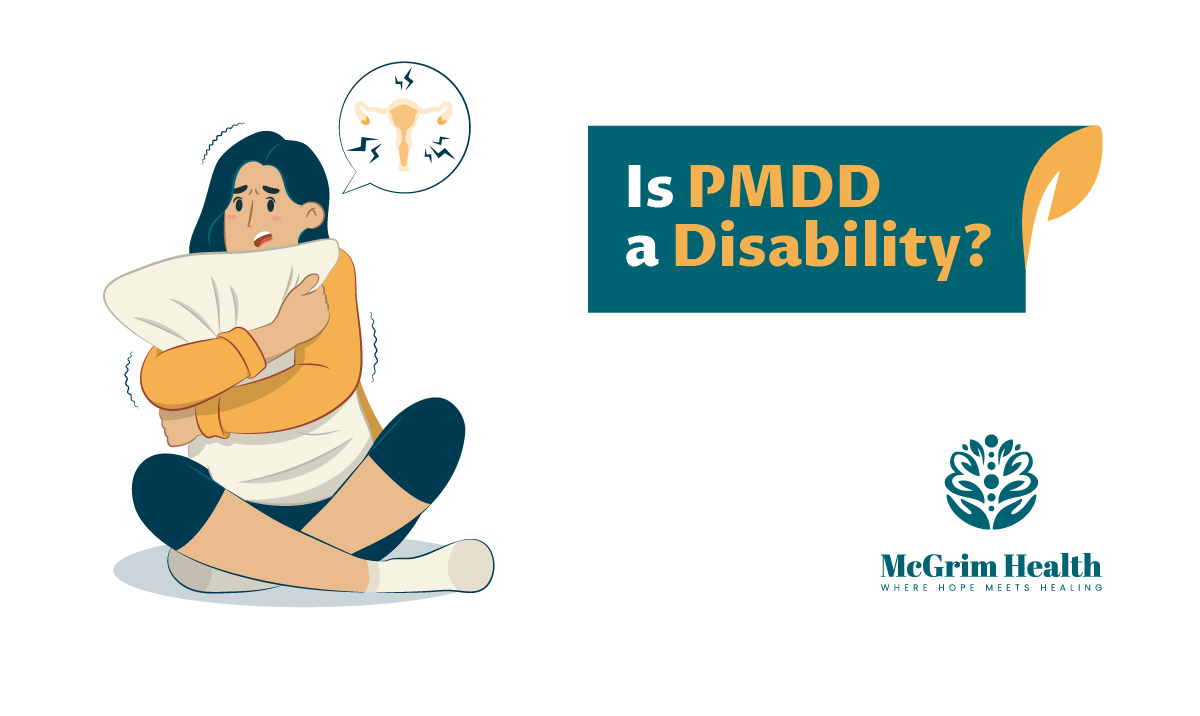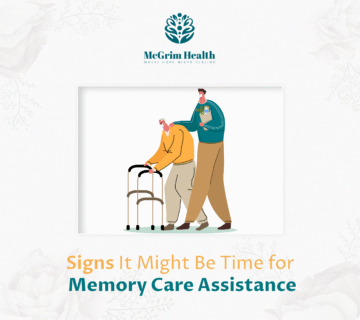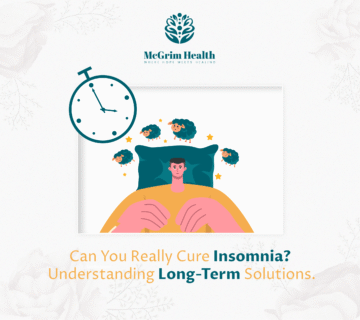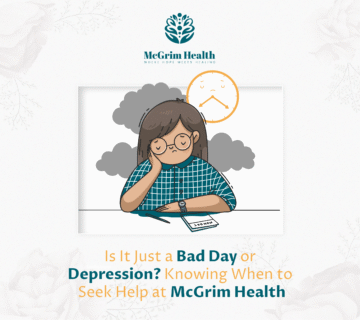Premenstrual dysphoric disorder, or PMDD, is a severe form of premenstrual syndrome (PMS). It makes you feel anxious, depressed, and irritable one to two weeks before your period.
According to research, up to 75% of people who have periods suffer from PMS.
However, PMDD is not very common. Only 3% to 8% of people who have it experience symptoms that get in the way of their daily lives.
When you want to treat mood disorders gently, McGrim Health is the best choice. We are here to help you get through this difficult time with care, support, and the best treatment for PMDD.
Let’s look into details, about premenstrual dysphoric disorder and is is PMDD a Disability
What is PMDD?
Premenstrual Dysphoric Disorder, or PMDD, is a long-term illness that is linked to PMS.
Anxiety, depression, and mood swings that are very bad are all signs of premenstrual syndrome (PMS). People with PMDD also have physical symptoms like headaches, bloating, and fatigue. These symptoms usually start a week or two before your period and go away soon after.
Is PMDD a Disability?
The Americans with Disabilities Act Amendments Act of 2008 (ADA) says that PMDD is a disability in the United States if it makes it very hard for a person to do normal things. For employees with disabilities like PMDD to be able to do their jobs well, employers must make reasonable accommodations.
Premenstrual Dysphoric Disorder Symptoms, Causes, and Diagnosis
Premenstrual Dysphoric Disorder (PMDD) can make daily life very hard. To deal with this condition well, you need to know its signs, understand what causes it, and get a correct diagnosis.
PMDD symptoms usually show up one to two weeks before a woman’s period, and they can be a mix of physical and mental signs.
Psychological Symptoms:
- Anxiety
- Sadness or depression
- Irritability or anger
- Loss of interest in daily activities
- Mood swings
- Difficulty concentrating
- Thoughts of self-harm or suicide
Physical Symptoms:
- Weight gain or bloating
- Breast tenderness
- Headaches or migraines
- Joint or muscle pain
- Changes in sex drive
- Difficulty sleeping
- Appetite changes
- Fatigue
- Acne
- Nausea
Risk Factors for PMDD:
Certain factors may increase the risk of developing PMDD symptoms, including:
- Family history of PMDD
- Thyroid disease or obesity
- abusing drugs or drinking too much alcohol
- Not getting enough exercise or living a sedentary life
How is PMDD Diagnosed?
Not many tests can be used to diagnose something besides a full medical history, physical exam, and pelvic exam. Your healthcare provider may suggest that you be checked for mental health issues because you are showing signs of mental illness.
Treatment Options for PMDD
If you have been diagnosed with Premenstrual Dysphoric Disorder (PMDD), there are a number of treatments that can help you deal with your symptoms. You can make a treatment plan that is unique to your needs with the help of your healthcare provider. Here are some possible ways to treat it:
- Antidepressant Medication
Antidepressants called selective serotonin reuptake inhibitors (SSRIs) are often prescribed to treat depression. By controlling serotonin levels in the brain, SSRIs can help ease the symptoms of PMDD.
- Talk Therapy
Talk therapy with a mental health professional, such as cognitive behavioral therapy (CBT) or other types of talk therapy, can help with mental health issues like anxiety and mood swings that come with PMDD.
- Birth Control Pills
Hormonal birth control, like birth control pills, patches, or hormonal intrauterine devices (IUDs), may help lessen the severity of PMDD symptoms by keeping hormone levels steady during the period.
- Diuretics
Diuretics, which are also called “water pills,” can help with the bloating and fluid retention that come with PMDD, making the symptoms better.
- Over-the-Counter Pain Medication
Nonsteroidal anti-inflammatory drugs (NSAIDs), such as ibuprofen (Advil) or naproxen (Aleve), can help with headaches, muscle aches, and menstrual cramps that are common during PMDD episodes.
It is important to talk to your healthcare provider about PMDD treatment medication and what treatment will work best for you and to keep track of how you are responding to treatment over time. You can control your PMDD symptoms and make your life better in general if you use the right set of treatments.
Preventing PMDD Episodes
There is no surefire way to completely stop PMDD, but making some changes to your lifestyle can help lessen the severity of your symptoms. You might want to make the following changes:
- Limit Alcohol and Caffeine
Avoiding or drinking less alcohol and caffeine can help keep your mood in check and lower the anxiety and irritability that come with PMDD.
- Watch Your Diet
Cutting back on sugar and salt and eating more whole grains, fruits, and vegetables can help your health in general and may help ease the symptoms of PMDD.
- Prioritize Sleep Hygiene
Set up good sleep habits by making a relaxing routine for before bed, staying away from screens before bed, and making sure your bedroom is cool, dark, and comfortable.
- Stay Active
Do some kind of physical activity every day. It can help your mood and ease the symptoms of PMDD. Aim to work out at a moderate level for at least 30 minutes most days of the week.
In conclusion, Is PMDD a disability?
While PMDD can make daily life very difficult, it is good to know that there are ways to handle symptoms that work.
With the right medical help, like medicine, therapy, and changes to their lives, people can feel better and have a better quality of life.
Getting professional help and making the necessary changes to their lifestyle can help people with PMDD control their condition and live full lives.
FAQs
What age does PMDD usually start?
PMDD can start at any point during a woman’s reproductive years, but most women do not have it until they are 26 years old. Like PMS, PMDD symptoms start in the late luteal phase of the menstrual cycle, which is after ovulation, and end soon after the first day of menstruation How does someone with PMDD act?
How does someone with PMDD act?
People who have premenstrual dysphoric disorder (PMDD) have PMS symptoms like headaches, bloating, and sore breasts in the weeks before their period.
But PMDD also leads to major anxiety, depression, and changes in mood. Suicidal thoughts happen to some people with PMDD. Birth control pills and antidepressants can help ease the symptoms.
Can PMDD go away with age?
PMDD and its signs go away when you reach menopause, which is the age when you no longer get periods.
Until then, though, symptoms can make things hard at work and in your relationships.
Some emotional or behavioral signs are suicidal thoughts and severe depression.





No comment